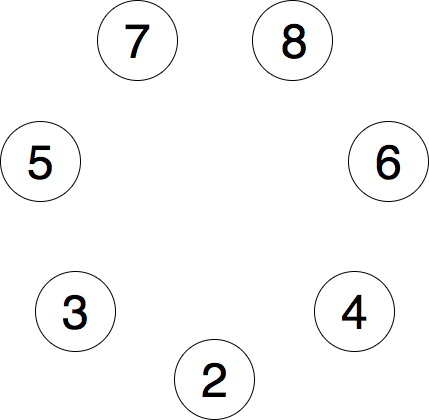We know that it's useful, even essential, to keep track of which place bells we are while ringing. During normal ringing, meaning ringing without mistakes, we work our way along the lines (or however we think about the method), and our awareness of the place bells might fade into the background. The place bell order just appears from the fact that we progress smoothly to the next lead end and become the next place bells according to the line.
If we make a mistake, however, assuming that we don't recover (with or without help) very quickly, the best chance of getting right is to know which place bells we should become at the next lead end, and rely on the conductor or the ringer of the trebles to announce when the lead end comes up.
If we stick to 8-bell methods for the moment, and assuming we are ringing methods with Plain Bob lead ends, there are 6 possible place bell orders. If we write the place bell order starting from 2, then the possible orders are 2468753, 2673485, 2836547, 2745638, 2584376, 2357864. For a further level of classification we can consider whether the method has a 2nd place lead end or an 8th place lead end - this gives 12 possible lead end types, as they are known.

Each lead end type has a conventional letter, which is used when quoting the lead end type of a method. For example, Cambridge is a B type method, which means the place bell order 2673485 with a 2nd place lead end. An alternative way of thinking about the place bell order is as a number, corresponding to how far one lead of the method takes us round the circle of numbers shown on the right. Plain Bob is +1, where + means moving anticlockwise. So that's the place bell order 2468753, stepping one place round the circle each time. Cambridge is +2. London is -1, or equivalently +6, but it's easier to keep the number as small as possible.
The table shows the lead end type, the place bell order, the number, and a (more or less) common method of that lead end type.
| Lead end type | Lead end place | Place bell order | Number | Method |
|---|---|---|---|---|
| A | 2nd | 2468753 | +1 | Cooktown Orchid |
| B | 2nd | 2673485 | +2 | Cambridge |
| C | 2nd | 2836547 | +3 | Cassiobury |
| D | 2nd | 2745638 | -3 | Ipswich |
| E | 2nd | 2584376 | -2 | Chesterfield |
| F | 2nd | 2357864 | -1 | London |
| G | 8th | 2468753 | +1 | Glasgow |
| H | 8th | 2673485 | +2 | Essex |
| J | 8th | 2836547 | +3 | Deva |
| K | 8th | 2745683 | -3 | Buckfastleigh |
| L | 8th | 2584376 | -2 | Cornwall |
| M | 8th | 2357864 | -1 | Bristol |
I find some place bell orders easier to work with than others. The most difficult ones are +3 and -3, because of lack of familiarity. It's also much easier to work out my next place bells if I'm coursing, because that feels the same as just working out the next place bell of the tenor - and then the 7th must be in the coursing relationship with the tenor.
An idea for working out the next place bells in +3 and -3 methods is to break the progression down into two steps. For example, +3 consists of +1 (Plain Bob - easy) followed by +2 (Cambridge - easy). I often use this technique for difficult place bell orders on tower bells. The main example is Zanussi, which is +5. I think of it as two leads of Cambridge followed by a lead of Plain Bob.
Another idea is to be aware of which relative position the bells are in: coursing, 3-4 or 5-6. Then, if we can track the place bell of one of them, and if we know the combinations of place bells that occur in each relative position, the task becomes easier. I have already mentioned this idea when ringing a coursing pair, especially the tenors. The place bell of the 7th is always the place bell of the tenor, +1 (where +1 means counting round the place bell diagram, as before). In the 3-4 position the relationship is +2, and in the 5-6 position the relationship is +3. If we know that the pairs of place bells in the 3-4 position are 2&6, 4&8, 6&7, 8&5, 7&3, 5&2, 3&4, then it's possible to know that if the first bell is, say, 6th place bell, then the other one must be 7th place bell. Of course the information in these pairs of place bells is the same as the information in the place bell order 2673485, but it's a different way of looking at it, which might be helpful.
This is all very well in theory, but like everything, it takes practice. Also, like conducting, the time when we really need to apply it is when everything is going wrong, which makes it so much more difficult to concentrate.